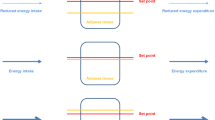Abstract
Energy expenditure is characteristic of every living cell; energy-rich nutrients are taken in and chemically converted, and ultimately metabolic end products with a lower energy content are eliminated from the cell (cf. pp. 598f.). The energy made available by this process is consumed in various ways. It is used, for example, to keep the cell’s structure (and thus its functional capacity intact, and to fuel specific cellular activities (such as the contraction of muscle cells).
Access this chapter
Tax calculation will be finalised at checkout
Purchases are for personal use only
Preview
Unable to display preview. Download preview PDF.
Similar content being viewed by others
References
Textbooks and Handbooks
Consolazio, C.F., Johnson, R.E., Pecora, L.J.: Physiological measurements of metabolic functions in man. New York-Toronto-London: McGraw-Hill 1963
Kestner, O., Knipping, H.W.: Die Ernährung des Menschen. Berlin: Springer 1924
Lavoisier, A.L., de LaPlace, P.S.: Abhandlung über die Wärme (Erstveröffentlichung 1780). In: Rosenthal, J. (Ed.): Zwei Abhandlungen über Wärme. Leipzig: Wilhelm Engelmann 1892
Lehmann, G.: Energetik des arbeitenden Menschen. In: Lehmann, G. (Ed.): Handbuch der gesamten Arbeitsmedizin, Bd. 1: Arbeitsphysiologie. Berlin-München-Wien: Urban & Schwarzenberg 1961
Opitz, E., Lübbers, D.: Allgemeine Physiologie der Zell- und Gewebsatmung. In: Büchner, F., Letterer, E., Roulet, F. (Eds.): Handbuch der allgemeinen Pathologie, Bd. 4, Teil II: Der Stoffwechsel. Berlin-Göttingen-Heidelberg: Springer 1957
Spitzer, H., Hettinger, Th., Kaminsky, G.: Tafeln für den Energieumsatz. (6. vollst. überarb. Aufl.) Berlin-Köln: Beuth 1982
Stegemann, J.: Leistungsphysiologie — Physiologische Grundlagen der Arbeit und des Sports. Stuttgart: Thieme 1984
Ulmer, H.-V.: Zur Methodik, Standardisierung und Auswertung von Tests für die Prüfung der körperlichen Leistungsfähigkeit. Köln: Deutscher Ärtzeverlag 1975
Wissenschaftliche Tabellen — Documenta Geigy. (Ed. J.R. Geigy A.G., Pharma, Basel). 7. Aufl. Basel: 1969
Original Papers and Reviews
Boothby, W.M., Berkson, J., Dunn, H.L.: Studies of the energy of metabolism of normal individuals: A standard of basal metabolism, with a nomogram for clinical application. Amer. J. Physiol 116, 468 (1936)
Douglas, C.G.: A method for determining the total respiratory exchange in man. J. Physiol. (London) 42, 17 (1911)
Göpfert, H., Bernsmeier, A., Stufler, R.: Über die Steigerung des Energiestoffwechsels und der Muskelinnervation bei geistiger Arbeit. Pflügers Arch. 256, 304 (1953)
Harris, J.A., Benedict, F.G.: A biometric study of basal metabolism in man. Publ. Nr. 279. Carneg. Inst., Washington 1919, cited in Stegemann, Leistungsphysiologie. Stuttgart: Thieme 1971
Long, C.L., Schaffel, N., Geiger, J.W., Schiller, W.R., Blakemore, W.S.: Metabolic response to injury and illness: Estimation of energy and protein needs from indirect calorimetry and nitrogen balance. J. Parent. Ent. Nutr. 3, 452 (1979)
Müller, E.A., Franz, H.: Energieverbrauchsmessungen bei beruflicher Arbeit mit einer verbesserten Respirationsgasuhr. Arbeitsphysiologie 14, 499 (1952)
Stegemann, J., Essfeld, D.: Advantages of the computerized breath-by-breath method for the interpretation of spiroergometric data. In: Löllgen, H., Mellerowicz, H. (Eds.): Progress in ergometry: Quality control and test criteria. p. 30, Berlin-Heidelberg-New York-Tokyo: Springer 1984
Semsroth, M.: Indirekte Kalorimetrie bei beatmeten Kindern. 2. Teil: Ein Meßverfahren und seine Überprüfung an einem neuentwickelten Stoffwechsel-Lungenmodell. Infusionstherapie 12, 294 (1985)
Editor information
Editors and Affiliations
Rights and permissions
Copyright information
© 1989 Springer-Verlag Berlin Heidelberg
About this chapter
Cite this chapter
Ulmer, H.V. (1989). Energy Balance. In: Schmidt, R.F., Thews, G. (eds) Human Physiology. Springer, Berlin, Heidelberg. https://doi.org/10.1007/978-3-642-73831-9_24
Download citation
DOI: https://doi.org/10.1007/978-3-642-73831-9_24
Publisher Name: Springer, Berlin, Heidelberg
Print ISBN: 978-3-642-73833-3
Online ISBN: 978-3-642-73831-9
eBook Packages: Springer Book Archive




